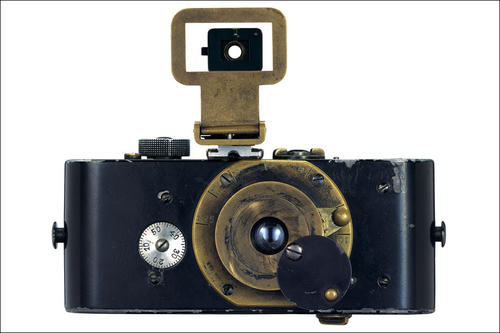A “Film Dinosaur” on the Wrong Track
Doctoral candidate Arne Keller studies why camera manufacturer Leica nearly failed
Mar 31, 2014
The original Leica: 100 years ago, Oskar Barnack, an employee of Ernst-Leitz-Werke Wetzlar and photography pioneer, designed the “Leitz Camera,” the first miniature camera, which Barnack himself dubbed the “Liliput-Kamera.”
Image Credit: Leica camera
Arne Keller is a doctoral student at the Pfadkolleg Research Center, which is based at the School of Business and Economics at Freie Universität.
Image Credit: Mirko Lux
What do department store chain Karstadt, Nokia, and Kodak have in common? All three have faced accusations of failing to respond in time to changing market conditions or new technologies. Long-standing camera manufacturer Leica also belongs on this list – it nearly missed the path to digital technology.
Arne Keller, a doctoral candidate at the Pfadkolleg Research Center, a research training group within the School of Business and Economics at Freie Universität, studied the Leica case for his dissertation.
Mr. Keller, how did Leica misread the signs of the times so badly that the company was on the brink of bankruptcy?
Interestingly, Leica Camera definitely did perceive at the time that the market was changing. In response, they established a division to conduct research on digital technology. But after initial successes, the company failed to integrate the knowledge that was generated into the core business. Leica then mistakenly assumed that a sufficiently large percentage of the market would remain analog, like with mechanical clocks and watches. The idea was to respond to the digital revolution by occupying a niche and continuing to offer analog cameras, which were supposed to be both traditional and luxury products at the same time.
As late as 2004, when digital cameras already accounted for 95 percent of the market, Leica’s management announced at the world’s largest photography trade fair – the Photokina, in Cologne – that the digital revolution was only an interlude, and that people would still be taking pictures on film in 20 years. At the fair Leica employees wore a pin reading “I am a film dinosaur.”
Although the entire market, and all the experts, said this strategy would be a flop, Leica continued to adhere to proven patterns of action and stuck to its plan of remaining analog. As a result, the company had unbelievable sales losses of 20 million euros in 2003, 2004, and 2005. Leica was on the verge of collapse – and there were a lot of signs at the time that the traditional company would follow the path taken by other companies in the industry, like Kodak, Polaroid, and Minolta.
How was Leica able to save itself?
Only through external intervention by two investors: the French luxury goods corporation Hermès and the Austrian strategic investor Andreas Kaufmann. They managed to realign Leica in two dimensions and reinvent the company as a brand in the luxury segment. Hermès had the idea of taking Leica completely out of specialized retail and transforming the brand into a kind of Gucci, Ferrari, or Apple of the camera industry. Today, Leica has about 120 flagship stores, which are more like boutiques than conventional camera stores.
And the Austrian investor’s involvement?
Kaufmann pushed Leica to move entirely into the digital world. The reason was that cameras are what are called system products, which means they are dependent on other products and services, such as film and photo labs. It was no longer possible to maintain the analog system in a market overwhelmingly dominated by digital products. The experimental working field tasked with researching digital technology – which Leica had established very early on, after all – made the company’s shift to digital not so difficult after all. Just two years after Kaufmann got involved, in 2006, Leica launched its first digital camera on the market.
So is this an example of a successful break from a path?
Exactly. I am interested in how companies can succeed in breaking free from dysfunctional paths and making strategic adjustments to accommodate changes in market and environmental conditions. Path dependencies, meaning sticking to structures, exist in practically every field. One of my colleagues in the research training group is studying how path-dependent the U.S. education system is, for example. Still others are studying health care networks and systems of working hours in corporate consulting.
The Pfadkolleg Research Center takes an interdisciplinary approach – what benefits does this bring for your work?
Sharing information and ideas is inspiring and effective and yields positive synergetic effects. And sometimes the differences within a single discipline are larger than those between two different ones, by the way.
Die Fragen stellte Mirko Lux
Further Information
Arne Keller, School of Business and Economics, Pfadkolleg Research Center, Tel. +49 30 838-57184, Email: arne.keller@fu-berlin.de


